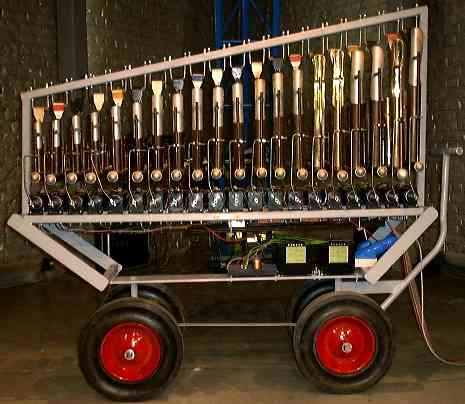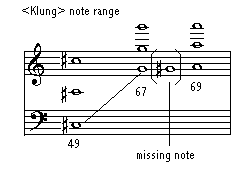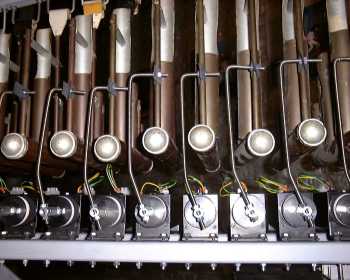Archival file describing version 1.0 from 2000
This instrument is a computer controlled acoustical angklung. The instrument can be played by standard MIDI commands, using our GMT software but is also capable of listening to pure algorithmic commands. It is mounted on a heavy duty trolley and can be taken on the road for street performances. In this case it is powered by a set of 3 12V lead batteries and control / programming takes place using either a subnotebook PC or a specific dedicated and preprogrammed microcontroller.

The picture to the right was taken during the construction of the instrument at a moment when it was functional but not completely finished. The only missing component is the lead battery compartiment and switch underneath the instrument.
<Klung> played its very first automated scales on sunday the 18th of june 2000.
On june 21th its builder wrote a tango for this instrument. This composition was called 'KlungelTango' and is scored for <Klung> in combination with a singer or a melodica. The computerprogram was written in <GMT> and is interactive. The piece can be performed on the street by a single performer. This tango was premiered on monday 4th of july, the melody performed by Karin Defleyt and the tango danced by the author with his partner, Moniek Darge. It was recorded for RTBF-television.
The instrument was made and designed to be a part of the <Slag-Werk> project realized for 'Web Strikes Back'at the occasion of the Tromp biannual, october 2000 in Eindhoven, the Netherlands.
A first composition that became a part the the <Web Strikes Back> project is called 'Klungels'. Both a version for the 'Klung' as a simulator version using real samples recorded from 'Klung' as well as a plain vanilla midi version is available as part for downloading from the Logos website. Work on this interactive software was also done by Kristof Lauwers. The musical range for this robot is:

Note that each note sounds in 3 octaves simultaneous.
The instrument uses following dedicated hardware:
1. a bus-board taking input from a parallel printer port ('centronics'-port) from a wintel PC with following schematic:
A note regarding wiring is appropriate here: if long flatcables are used to connect this board to the PC it is highly recommended to insert an extra TTL buffer in all data lines. On older computers , with printer-ports on the ISA bus we never had a problem, since these cards used quite rugged traditional TTL chips. However, on computers where the printer ports resides on the planar, SMD components are used that cannot safely handle long and hence high capacity lines on this port. We blew the printer port on one of our Intel celeron motherboards during code development for this and similar automated instruments!
2. Two note driver boards, each board driving a single movement direction of the solenoids:
[comment on these circuits, first
developed for the first versions of our player piano can be found at/kursus/2116.html.]
Note that the solenoids we used have double windings, one winding for each direction
of movement. Thus no return springs are mounted
There are 20 anklung-notes in the intrument, each note always sounding in 3 octaves, as usual on the original indonesian instruments, made of bamboo. Our anklung however does not use bamboo but brass tubing and was rebuild from an old German instrument designed to be used in the circus. The original instrument was to be used by a musical clown and even had small electric lights fitted. This use explains why the tuning of the instrument conforms to A=440Hz and is tuned in equal temperament. The ambitus is C#- A(49 - 69). The angklungs are actioned by strong bidirectional solenoids. These are rated nominally 24V/ 1A delivering a force of 24 Newton. In order to get a higher range of striking velocities, we operate these solenoids at twice the rated voltage, limiting the duty cycle to 25%. At these voltage levels, users should never leave the coils under current. Doing this has no musical advantages nor uses and may only lead to an early death of the solenoids.
3. The 40 power mosfets we used for controlling these solenoids are Harris RFP10N12L (or the equivalent IRL640), since these switch on TTL levels and are capable of dissipating 60Watts. The current rating is 10A and their Uds limit is 120V. The rather high gate capacitance (1200pF) is not a real problem since switching speeds in this application are inherently pretty slow. For this reason we did not fit a resistor between gate and ground in the driver circuit. Note that when the power supply is switched on, all latches will go to a high state, thus sounding al notes at the same time. To avoid this, we modified Klung in 2002 such that the instrument now has to receive a pincode from the connected PC before it will be fully powered on. A program written in <GMT>, converting midi input into the appropriate Klung control command is available. The midi implementation is as follows:
- Note ON commands (144+channel, notebyte,velocity) on the selected channel for the notes 49 to 69 toggle the angklungs either forwards or backwards. The velocity controls the striking force and corresponds to the electrical pulse duration expressed in ms.
- Note Aftertouch command can be used to set a periodic shaking frequency for the playing note. The command is 160 + channel, notebyte, period. The period is a value between 1 and 127 and is converted to 0.2 to 25.4Hz. (divide the midi byte by 5 to get the shaking frequency in Hz)
- Note OFF command switch notes off ,also when aftertouch command were sent. When aftertouch commands are not used, it is not strictly essential to send note off commands.
4. The power supply for this instrument is rated for 600Watts. The only reason for using two transformers had to do with the availability of off the shelve transformers in our regular electronic hardware retail store. The 5V required for the logic circuits is derived from this same supply, via a power zenerdiode (rated 16V / 50W) in series with a standard 7805 regulator. (not drawn). The BDX67 power darlingtons (rated at 16A each) serve as rough voltage regulators. The zener diode in the base is a 5Watt type. If car batteries are used: the instrument will function with a single 24V battery, but it is preferred to use 3 smaller 12 V batteries in series. A capacity of 10Ah is enough for about 4 hours of uninterupted autonomous playing. Obviously average current consumption depends highly on the music to be performed... Do never connect the batteries when the power supply is connected as well. This power supply is not designed to function as a battery charger.
Music:

Specific compositions for this instrument are written by Kristof Lauwers, Brent Wetters, Thomas Smettryns, Kris De Baerdemacker, Charlemagne Palestine and myself. We herewith invite any composer interested, in submitting a piece for <Klung>. The midi implementation, for people not using <GMT> is as follows:
To shake the anklungs: notes 49 to 69, the shaking direction will alternate automatically. Note that note 68/92 (G#) is missing in the instrument. You should limit the shaking speed to lower than 12 beats a second. Velocity is implemented, so you can do crescendo's, accents etc... Note for GMT-programmers only: Avoid leaving notes on, since this causes the solenoids to get very hot. A fortiori, users should never have a note on at the same time as its double octave. This would energize both windings resulting in zero force and maximum dissipation and heat... (These precautions are not to be observed by midi composers, since our drivers take care of it).
If you are using <GMT> under Power Basic, you can use all specific hardware control functions and procedures provided in our library. The low level functions can also be used by C programmers, since they are exported and reside in a standard DLL library. It is also possible to controll <Klung> using a microcontroller or even a simple Basic Stamp: the BS2 stamp just works nicely. You have to code a 'centronics klone' using 12 of the I/O lines and send your data to the port conforming to the protocol. Coding examples are available on this website in the GMT directory...
Available compositions and/or arrangements for <Klung>:
- 'KlungelTango' by Godfried-Willem Raes
- 'Klungels' by Godfried-Willem Raes
- 'StochKlung' by Kristof Lauwers
- "To Brent 2" by Thomas Smetryns
 Click
here to hear this piece in MP3 format:
Click
here to hear this piece in MP3 format:- "Trio Paradiso" (for Klung, Harma and Vibi) by Godfried-Willem Raes .
- "Paradiso" (for <Vibi>,<Klung>,<Harma>,<Piperola>,<Player Piano>,<Troms>
- "GestroMetals" (for <Belly>,<Klung>,<Vibi> and invisible instrument)
- "Grays for Klung" by Godfried-Willem Raes
- "Rolands Round" by Godfried-Willem Raes
- "Klungel Harm" by Godfried-Willem Raes
Concerts where <Klung> could be heard:
- Sunday 10th of september 2000, Kasteelpark Melle, Brusselsesteenweg (near Gent).
- Tuesday 17th of october 2000: Logos Tetrahedron: Try out concert
- Tuesday 24th to Sunday 29th of october 2000, Eindhoven, TU: <Web Strikes Back Project>,(Netherlands)
- Thursday august 2nd 2001, Ghent: Logos Tetrahedron
- Sunday september 9th 2001, Sint Truiden, Stadhuis (10u00-18u00)
- Thursday october 27-29 2001, Tourcoing, Le Grand Mix (France)
- Monday november 12th 2001, Amsterdam, Paradiso (Netherlands)
- Saturday december 1th,2001, Herne, Teutoburgia Halle (Germany)
- Tuesday december 4th, 2001, Ghent, Logos Tetrahedron
- March 27th, 2002, Ghent, Logos Tetrahedron (M&M ensemble)
- April 23th, 2002, Ghent, Logos Tetrahedron (M&M ensemble)
- July 20th,21th and 22nd, 2002, Ghent, Logos Tetrahedron (M&M ensemble)
- August 10th and 11th, 2002, Ghent, Paterholfeesten, Oudburg
- August 12th, 2002, Ghent, Logos Tetrahedron (M&M ensemble)
- November 28th, 2002, Enschede, Tart Symposium (M&M ensemble)
- December 19th, 2002, Ghent, Logos Tetrahedron (M&M ensemble)
- Februari 13th, 2003, Ghent, Logos Tetrahedron (M&M ensemble)
- March 13th, 2003, Ghent, Logos Tetrahedron (M&M ensemble)
- October 2003, Den Haag, Festival De Branding (M&M ensemble)
- January 2004, Den Haag, Korzo Festival (M&M ensemble)
- January 2004, Lille, Lille 2004 Robots (M&M ensemble)
- April 2004, Paris, France (M&M ensemble)
- March 2005, Leuven, Stuk (M&M ensemble)
- July 2005, Muenchen ,Germany (M&M ensemble)
- August 2005, Ruemlingen Festival ,Switserland (M&M ensemble)
- October 2005, Leuven, Transit Festival (M&M ensemble)
- December 2005, Ghent, Logos Tetrahedron (M&M ensemble)
- March 2006, Ghent, Logos Tetrahedron (M&M ensemble)
Downloadable simulation:
Collaborators on the construction and maintenance of <Klung>:
- Kurd Vandevelde
- Moniek Darge
- Bert Vandekerckhove
- Xavier Verhelst
Collaborators on the <Klung> software:
- Kristof Lauwers
- Johannes Taelman (PIC version planned for 2006)
Dimensions:
- width: 1650 mm (with handle, 1750mm)
- height: 1600mm
- depth: 52 0mm
- weigth: 200kg
- power consumption: 600Watts / 230V AC or 36V / 10A DC, from lead battery, for ca. 3 hours of autonomy.
- data input: centronics parallel port from Wintel PC (only under Win98 and Millenium), National Instruments DIO-24 PCMCIA Card (Win NT and Win2000) or dedicated microcontroller. In 2006 <Klung> will be rebuild such as to use PIC microcontrollers instead of a dedicated laptop.
Insurance value: 12.000 Euro.
The <Klung> automat can be heard on the Logos Public Domain CD <Automaton> (LPD007)., as well as -in combination with many more automats in CD <M&M> (LPD008). It is also featured on LPD0014: <Robodies> (2005)
| Back to Web Strikes Back | Back to logos' main index page | To homepage Godfried-Willem Raes | To 2006 version of <Klung> | Midi implementation table |
28.12.2006: De twee oude latch printen kado gedaan aan Yvan Vander Sanden voor toepassing in diens automatisch orgel positiefje.
Last update: 2006-12-20

